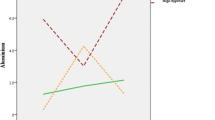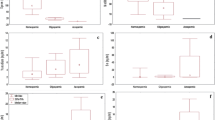Abstract
Studies suggest a relationship between semen quality and the concentration of trace elements in serum or seminal plasma. However, trace elements may be linked to DNA and capable of altering the gene expression patterns. Thus, trace element interactions with DNA may contribute to the mechanisms for a trans-generational reproductive effect. We developed an analytical method to determine the amount of trace elements bound to the sperm DNA, and to estimate their affinity for the sperm DNA by the ratio: R = Log [metal concentration in the sperm DNA/metal concentration in seminal plasma]. We then analyzed the concentrations of 15 trace elements (Al, Cd, Cr, Cu, Hg, Mn, Mo, Ni, Pb, Ti, V, Zn, As, Sb, and Se) in the seminal plasma and the sperm DNA in 64 normal and 30 abnormal semen specimens with Inductively Coupled Plasma/Mass Spectrometry (ICP-MS). This study showed all trace elements were detected in the seminal plasma and only metals were detected in the sperm DNA. There was no correlation between the metals’ concentrations in the seminal plasma and the sperm DNA. Al had the highest affinity for DNA followed by Pb and Cd. This strong affinity is consistent with the known mutagenic effects of these metals. The lowest affinity was observed for Zn and Ti. We observed a significant increase of Al linked to the sperm DNA of patients with oligozoospermia and teratozoospermia. Al’s reproductive toxicity might be due to Al linked to DNA, by altering spermatogenesis and expression patterns of genes involved in the function of reproduction.

Similar content being viewed by others
References
Geoffroy-Siraudin C, Loundou AD, Romain F, Achard V, Courbiere B, Perrard MH, et al. (2012) Decline of semen quality among 10 932 males consulting for couple infertility over a 20-year period in Marseille, France. Asian J Androl 14:584–590
Al Bakheet SA, Attafi IM, Maayah ZH, Abd-Allah AR, Asiri YA, Korashy HM (2013) Effect of long-term human exposure to environmental heavy metals on the expression of detoxification and DNA repair genes. Environ Pollut 181:226–232
Godschalk R, Hogervorst J, Albering H, Mercelina-Roumans P, van Schooten FJ, de Haan J, et al. (2005) Interaction between cadmium and aromatic DNA adducts in hprt mutagenesis during foetal development. Mutagenesis 20:181–185
Xu DX, Shen HM, Zhu QX, Chua L, Wang QN, Chia SE, et al. (2003) The associations among semen quality, oxidative DNA damage in human spermatozoa and concentrations of cadmium, lead and selenium in seminal plasma. Mutat Res 534:155–163
Venkatramreddy V, Tchounwou PB (2013) Oxidative stress and DNA damage induced by chromium in liver and kidney of goldfish, Carassius auratus. Biomark Insights 8:43–51
Caicedo M, Jacobs JJ, Reddy A, Hallab NJ (2007) Analysis of metal ion-induced DNA damage, apoptosis, and necrosis in human (Jukart) T-cells demonstrates Ni2+ and V3+ are more toxic than other metals: Al3+, Be2+, Co2+, Cr3+, Cu2+, Fe3+, Mo5+, Nb5+, Zr2+. J Biomed Mater Res Part A:905–913
Kawata K, Shimazaki R, Okabe S (2009) Comparison of gene expression profiles in HepG2 cells exposed to arsenic, cadmium, nickel, and three model carcinogens for investigating the mechanisms of metal carcinogenesis. Environ Mol Mutagen 50:46–59
Sorokin VA, Valeev VA, Gladchenko GO, Sysa IV, Blagoi YP, Volchok IV (1996) Interaction of bivalent copper, nickel, manganese ions with native DNA and its monomers. J Inorg Biochem 63:79–98
Mazzuca D, Russo N, Toscano M, Grand A (2006) On the interaction of bare and hydrated aluminum ion with nucleic acid bases (U, T, C, a, G) and monophosphate nucleotides (UMP, dTMP, dCMP, dAMP, dGMP). J Phys Chem B 110:8815–8824
Zhang X, Wang F, Liu B, Kelly EY, Servos MR, Liu J (2014) Adsorption of DNA oligonucleotides by titanium dioxide nanoparticles. Langmuir 30:839–845
Millonig H, Pous J, Gouyette C, Subirana JA, Campos JL (2009) The interaction of manganese ions with DNA. J Inorg Biochem 103:876–880
Smith NM, Amrane S, Rosu F, Gabelica V, Mergny JL (2012) Mercury-thymine interaction with a chair type G-quadruplex architecture. Chem Commun (Cambridge, England) 48:11464–11466
Koc H, Swenberg JA (2002) Applications of mass spectrometry for quantification of DNA adducts. J Chromatogr 778:323–343
Carette D, Perrard MH, Prisant N, Gilleron J , Pointis G, Segretain D, Durand D. Hexavalent chromium at low concentration alters Sertoli cell barrier and connexin-43 gap junction but not claudin-11 and N-cadherin in the rat seminiferous tubule culture model. Toxicol Appl Pharmacol 2013;268:27–36.
Chung NP, Cheng CY (2001) Is cadmium chloride-induced inter-Sertoli tight junction permeability barrier disruption a suitable in vitro model to study the events of junction disassembly during spermatogenesis in the rat testis? Endocrinology 142:1878–1888
Oldereid NB, Thomassen Y, Purvis K (1998) Selenium in human male reproductive organs. Hum Reprod 13:2172–2176
Bjorndahl L, Kvist U (2010) Human sperm chromatin stabilization: a proposed model including zinc bridges. Mol Hum Reprod 16:23–29
Lai JC, Lai MB, Jandhyam S, Dukhande VV, Bhushan A, Daniels CK, et al. (2008) Exposure to titanium dioxide and other metallic oxide nanoparticles induces cytotoxicity on human neural cells and fibroblasts. Int J Nanomedicine 3:533–545
Ema M, Kobayashi N, Naya M, Hanai S, Nakanishi J (2010) Reproductive and developmental toxicity studies of manufactured nanomaterials. Reprod Toxicol (Elmsford, NY) 30:343–352
Peto MV (2010) Aluminium and iron in humans: bioaccumulation, pathology, and removal. Rejuvenation Res 13:589–598
Kim H, Lee HJ, Hwang JY, Ha EH, Park H, Ha M, et al. (2010) Blood cadmium concentrations of male cigarette smokers are inversely associated with fruit consumption. J Nutr 140:1133–1138
Barceloux DG (1999) Chromium. J Toxicol Clin Toxicol 37:173–194
Von Burg R, Liu D (1993) Chromium and hexavalent chromium. J Appl Toxicol 13:225–230
World Health Organisation (2010) WHO Laboratory manual for the examination and processing of human semen. WHO Press, Geneva
Auger J, Eustache F, David G (2000) Standardisation de la classification morphologique des spermatozoïdes humains selon la méthode de David modifiée. Andrologie 10:358–373
Queiroz EK, Waissmann W (2006) Occupational exposure and effects on the male reproductive system. Cad Saude Publica 22:485–493
Minguez-Alarcon L, Mendiola J, Roca M, Lopez-Espin JJ, Guillen JJ, Moreno JM, et al. (2012) Correlations between different heavy metals in diverse body fluids: studies of human semen quality. Adv Urol 2012:420893
Giaccio L, Cicchella D, De Vivo B, Lombardi G, De Rosa M (2012) Does heavy metals pollution affects semen quality in men? A case of study in the metropolitan area of Naples (Italy). J Geochem Explor 112:218–225
Benoff S, Centola GM, Millan C, Napolitano B, Marmar JL, Hurley IR (2003) Increased seminal plasma lead levels adversely affect the fertility potential of sperm in IVF. Hum Reprod 18:374–383
Mendiola J, Moreno JM, Roca M, Vergara-Juarez N, Martinez-Garcia MJ, Garcia-Sanchez A, et al. (2011) Relationships between heavy metal concentrations in three different body fluids and male reproductive parameters: a pilot study. Environ Health 10:6
Telisman S, Cvitkovic P, Jurasovic J, Pizent A, Gavella M, Rocic B (2000) Semen quality and reproductive endocrine function in relation to biomarkers of lead, cadmium, zinc, and copper in men. Environ Health Perspect 108:45–53
Telisman S, Colak B, Pizent A, Jurasovic J, Cvitkovic P (2007) Reproductive toxicity of low-level lead exposure in men. Environ Res 105:256–266
Li P, Zhong Y, Jiang X, Wang C, Zuo Z, Sha A (2012) Seminal plasma metals concentration with respect to semen quality. Biol Trace Elem Res 148:1–6
Rossman TG, Klein CB (2011) Genetic and epigenetic effects of environmental arsenicals. Metallomics 3:1135–1141
ViIlaverde AISB, Fioratti EG, Ramos RS, Neves RCF, Ferreira JCP, Cardoso GS, Padilha PM, Lopes MD (2014) Blood and seminal plasma concentrations of selenium, zinc and testosterone and their relationship to sperm quality and testicular biometry in domestic cats. Anim Reprod Sci 150:50–55
Atig F, Raffa M, Habib BA, Kerkeni A, Saad A, Ajina M (2012) Impact of seminal trace element and glutathione levels on semen quality of Tunisian infertile men. BMC Urol 12:6–13
Figa-Talamenca I, Traina ME, Urbani E (2001) Occupational exposure to metals, solvents and pesticides: recent evidence on male reproductive effects and biological markers. Occup Med 51:174–188
Hovatta O, Venalainen ER, Kuusimaki L, Heikkila J, Hirvi T, Reima I (1998) Aluminium, lead and cadmium concentrations in seminal plasma and spermatozoa, and semen quality in Finnish men. Hum Reprod 13:115–119
Klein JP, Mold M, Mery L, Cottier M, Exley C (2014) Aluminum content of human semen: implications for semen quality. Reprod Toxicol (Elmsford, NY) 50:43–48
Alexander BH, Checkoway H, Faustman EM, van Netten C, Muller CH, Ewers TG (1998) Contrasting associations of blood and semen lead concentrations with semen quality among lead smelter workers. Am J Ind Med 34:464–469
Exley C (2013) Human exposure to aluminium. Environ Sci Process Impacts 15:1807–1816
Bagchi D, Stohs SJ, Downs BW, Bagchi M, Preuss HG (2002) Cytotoxicity and oxidative mechanisms of different forms of chromium. Toxicology 180:5–22
Aduayom I, Campbell PG, Denizeau F, Jumarie C (2003) Different transport mechanisms for cadmium and mercury in Caco-2 cells: inhibition of Cd uptake by Hg without evidence for reciprocal effects. Toxicol Appl Pharmacol 189:56–67
Zhang RY, Liu Y, Pang DW, Cai RX, Qi YP (2002) Spectroscopic and voltammetric study on the binding of aluminium (III) to DNA. Anal Sci 18:761–766
Rani A, Kumar A, Lal A, Pant M (2014) Cellular mechanisms of cadmium-induced toxicity: a review. Int J Environ Health Res 24:378–399
Acknowledgments
We thank C. Metton, M.J. Fays-Bernardin, and D. Daioglou for their technical assistance as well as Germetheque for their support.
Author information
Authors and Affiliations
Corresponding author
Ethics declarations
Funding Source and Approval Committee
GERMETHEQUE biobank (France, Marseille University Hospital la Conception) provided all samples and exposure data. In accordance with the 1975 Helsinki Declaration on human experimentation, GERMETHEQUE obtained consent to use each participant’s samples in the human fertility studies. The Germetheque scientific committee approved the study design, and, as a consequence, GERMETHEQUE was validated by the Institutional Review Board (CPP Sud-Ouest and Outremer, n°2-15-27).
The Germetheque sample collection was supported by grants from the ANR (Agence Nationale pour la Recherche), the ABM (Agence de la Biomédecine), the Centre Hospitalier Universitaire de Toulouse, and APHM (Assistance Publique Hôpitaux de Marseille).
Additional information
Sazan Ali and Florence Chaspoul participated equally in this work.
Rights and permissions
About this article
Cite this article
Ali, S., Chaspoul, F., Anderson, L. et al. Mapping Fifteen Trace Elements in Human Seminal Plasma and Sperm DNA. Biol Trace Elem Res 175, 244–253 (2017). https://doi.org/10.1007/s12011-016-0772-6
Received:
Accepted:
Published:
Issue Date:
DOI: https://doi.org/10.1007/s12011-016-0772-6




